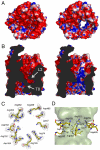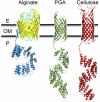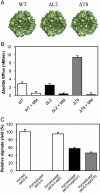Structural basis for alginate secretion across the bacterial outer membrane
- PMID: 21778407
- PMCID: PMC3156188
- DOI: 10.1073/pnas.1104984108
Structural basis for alginate secretion across the bacterial outer membrane
Abstract
Pseudomonas aeruginosa is the predominant pathogen associated with chronic lung infection among cystic fibrosis patients. During colonization of the lung, P. aeruginosa converts to a mucoid phenotype characterized by the overproduction of the exopolysaccharide alginate. Secretion of newly synthesized alginate across the outer membrane is believed to occur through the outer membrane protein AlgE. Here we report the 2.3 Å crystal structure of AlgE, which reveals a monomeric 18-stranded β-barrel characterized by a highly electropositive pore constriction formed by an arginine-rich conduit that likely acts as a selectivity filter for the negatively charged alginate polymer. Interestingly, the pore constriction is occluded on either side by extracellular loop L2 and an unusually long periplasmic loop, T8. In halide efflux assays, deletion of loop T8 (ΔT8-AlgE) resulted in a threefold increase in anion flux compared to the wild-type or ΔL2-AlgE supporting the idea that AlgE forms a transport pathway through the membrane and suggesting that transport is regulated by T8. This model is further supported by in vivo experiments showing that complementation of an algE deletion mutant with ΔT8-AlgE impairs alginate production. Taken together, these studies support a mechanism for exopolysaccharide export across the outer membrane that is distinct from the Wza-mediated translocation observed in canonical capsular polysaccharide export systems.
Conflict of interest statement
The authors declare no conflict of interest.
Figures





References
-
- Gacesa P. Bacterial alginate biosynthesis—recent progress and future prospects. Microbiology. 1998;144:1133–1143. - PubMed
-
- Ramsey DM, Wozniak DJ. Understanding the control of Pseudomonas aeruginosa alginate synthesis and the prospects for management of chronic infections in cystic fibrosis. Mol Microbiol. 2005;56:309–322. - PubMed
-
- Parsek MR, Singh PK. Bacterial biofilms: an emerging link to disease pathogenesis. Annu Rev Microbiol. 2003;57:677–701. - PubMed
-
- Baltimore RS, Shedd DG. The role of complement in the opsonization of mucoid and non-mucoid strains of Pseudomonas aeruginosa. Pediatr Res. 1983;17:952–958. - PubMed
MeSH terms
Substances
Associated data
- Actions
Grants and funding
LinkOut - more resources
Full Text Sources
Molecular Biology Databases

